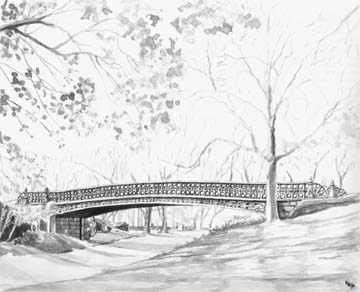Pine Bank Arch is located just east of the West Drive in line with 62nd Street. Standing within 200 feet of Greyshot Arch, it carries a 16-foot-wide pedestrian walkway 11 feet above the bridle path.
The cast-iron span was spared when the south and east lengths of the bridle path were eliminated during the modernization sweep of the 1930s. Two other cast-iron bridges over the bridle path, unfortunately, became the era's casualties. Subsequent neglect of Pine Bank Arch over the years almost accomplished what demolition could do in a day.
Pine Bank Arch was restored in 1984 with the Parks Department's plan for rehabilitation of park structures. Steel in the reinforced concrete deck had suffered from extensive rust in some places, and sections of the handrails and posts were missing. Some small cast-iron details had even rusted away.
In the restoration several costly and painstaking steps were involved: the fabrication of missing parts, assembly, scraping old paint and rust on the remaining structure, reassembling, and finally repainting. The deck of concrete was replaced with the wood we see today.
Long called Pine Bank Arch, this pedestrian crossover is more accurately a bridge. The 80-foot-long walkway is situated between two long, sloping natural rock outcroppings and has two shaped concrete [sic] on the remaining structure, reassembling, and finally repainting. The deck of concrete was replaced with the wood we see today.
The delicate, ornate, somewhat Gothic handrail was cast in parts and assembled with nuts and bolts. Some of the original drawings bear the signature of the New York Foundry. Large castings were the work of craftsmen from the J. B. and W. W. Cornell Ironworks. Posts and railings at each end of the bridge were taken into storage at the city's facility for monumental artifacts housed on Randall's Island. The restoration allows the cast-iron latticework to be seen again in its full splendor in Central Park. A final touch was planting white pine on the east flank.

Original drawing for ironwork. 1860.
Municipal Archives.



